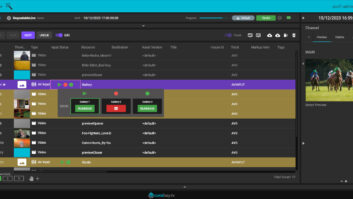It hasn’t even been two years since publication of the initial SMPTE ST 2110 suite of standards for Professional Media Over IP Networks, but the IP transformation has made big strides on a global scale. Major IP installations are now up and running on every major continent, and broadcasters have all invested in the new technologies while high-profile events have also come onboard to rely on IP-based systems for remote production. One would think that with the success of SMPTE ST 2110 that standards and specification efforts related to IP for broadcast would slow down, but they have not. Why? While SMPTE ST 2110 laid a great foundation and delivers on benefits such as format flexibility, scalability and resource sharing, there is still much to do to realise the full potential and benefit of IP technology.
Enter JT-NM TR-1001-1: a practical approach to IP deployment
SMPTE ST 2110 laid the critical foundation for IP adoption by describing the means of transporting video, audio, and ancillary data over IP networks within facilities. While early SMPTE ST 2110 installations have been very successful and delivered on a clear set of benefits such as scale and format flexibility, broadcasters have recognised the need to streamline and simplify the system installation and configuration experience, particularly in a multi-vendor environment. Answering this call, the Joint Task Force for Network Media (JT-NM, comprised of AMWA, EBU, SMPTE and VSF) collaborated to create a new specification, JT-NM TR-1001-1. Entitled “System Environment and Device Behaviors For SMPTE ST 2110 Media Nodes in Engineered Networks”, JT-NM TR-1001-1 provides much needed specifications and guidance enabling much more streamlined and straightforward configuration of SMPTE ST 2110 based systems. The JT-NM TR-1001-1 document puts it this way:
“The goal of this document is to enable the creation of network environments where an end-user can take delivery of new equipment (compliant to this recommendation), connect it to their network, and configure it for use, with a minimum amount of human interaction. Specifically, the interaction ought to be limited to acknowledging the equipment’s existence (for security reasons), assigning operational names to the signals the equipment generates, and defining any grouping relationships the signals might have with other existing signals. Technical configuration of the equipment in regard to timing, signal transport, and routing interactions is automated by the behaviours and management systems described in this recommendation.”
Is this specification important? Very much so. While SMPTE ST 2110 has enjoyed widespread adoption and success on many a major stage, putting together a multi-vendor system, while absolutely achievable, has typically taken longer than if the system had been deployed as a single vendor system or a multi-vendor SDI system. JT-NM TR-1001-1 automates much of the system configuration and sets operating points such that system commissioning time can be greatly reduced.
Extending the benefits of standards-based IP
Given what JT-NM TR-1001-1 enables as described above, it is more than a “nice-to-have” for many applications. JT-NM TR-1001-1 will literally expand the usefulness and reach of SMPTE ST 2110. No longer will SMPTE ST 2110 be best suited for fixed facilities or to those organisations with deep IP knowledge. As JT-NM TR-1001-1 is supported by more and more equipment vendors, it will become much easier to deploy and manage SMPTE ST 2110 systems. This means that set-up/tear-down applications such as fly packs and a wider set of organisations will be able to harness the power of IP in their facilities. More and more organisations will be able to implement systems that enable flexibility to migrate from HD to UHD, systems that scale beyond existing limits and systems that enable more efficient sharing of resources. It is for this reason that the Alliance for IP Media Systems (AIMS) has heartily endorsed JT-NM TR-1001-1 by adding the specification to its roadmap.
This article first appeared in TVBEurope’s 2019 MediaTech Outlook. Download the ebook here.







